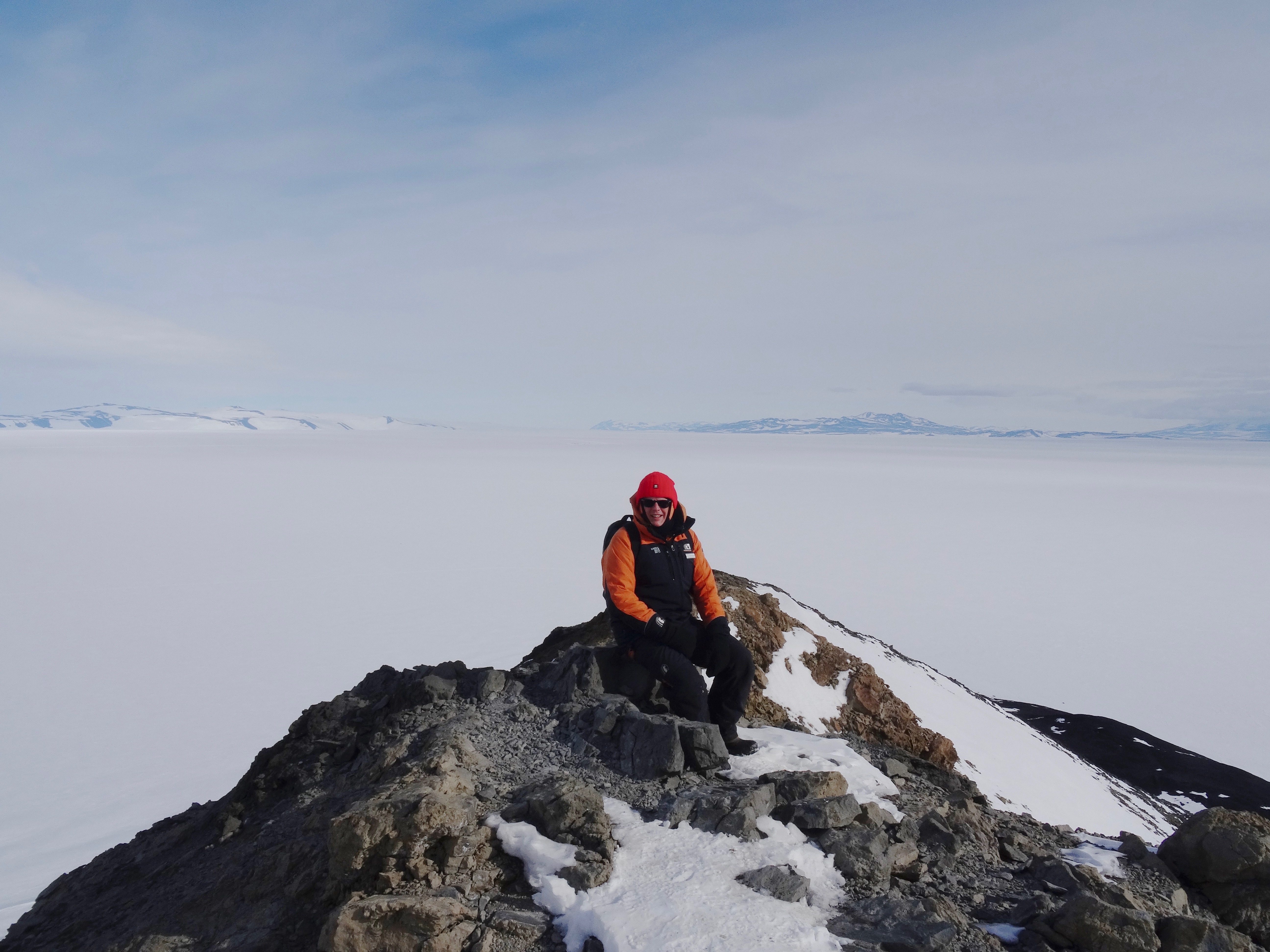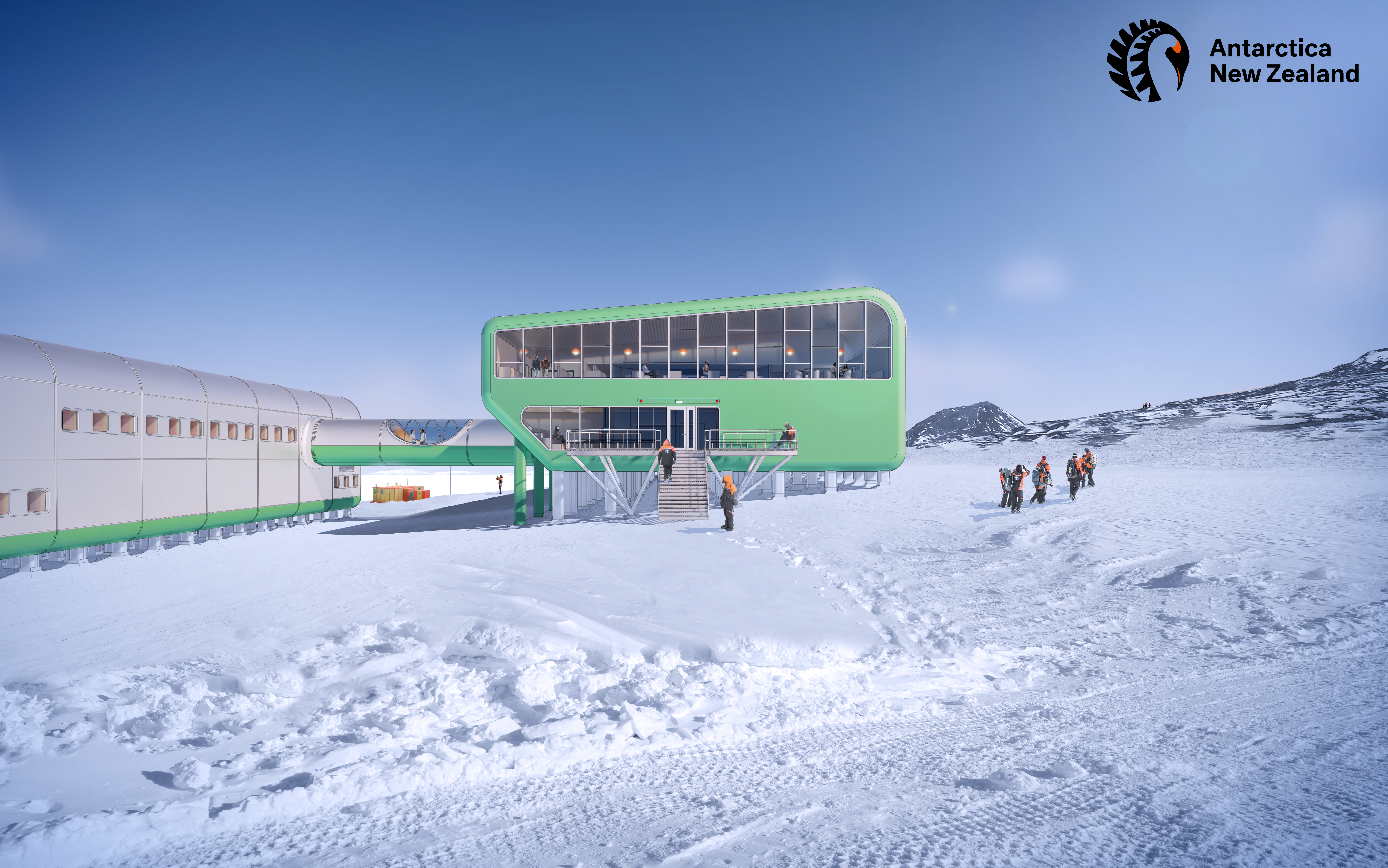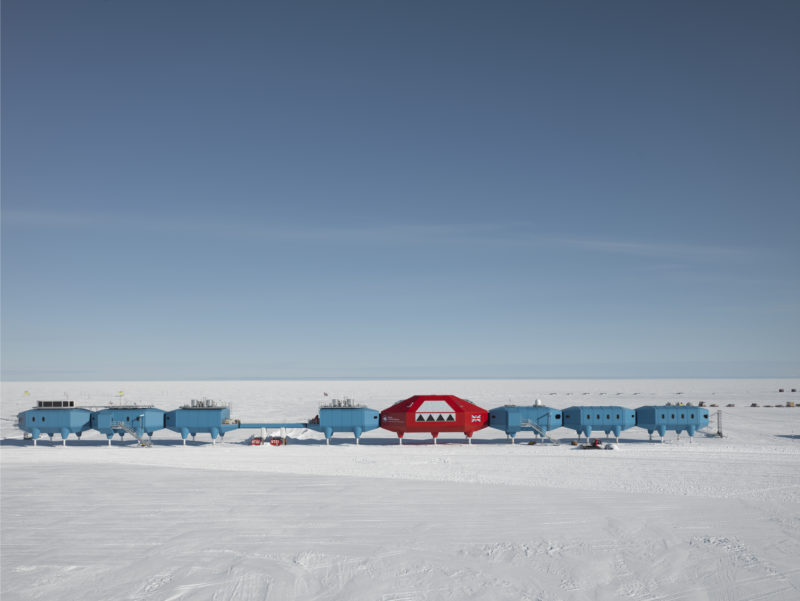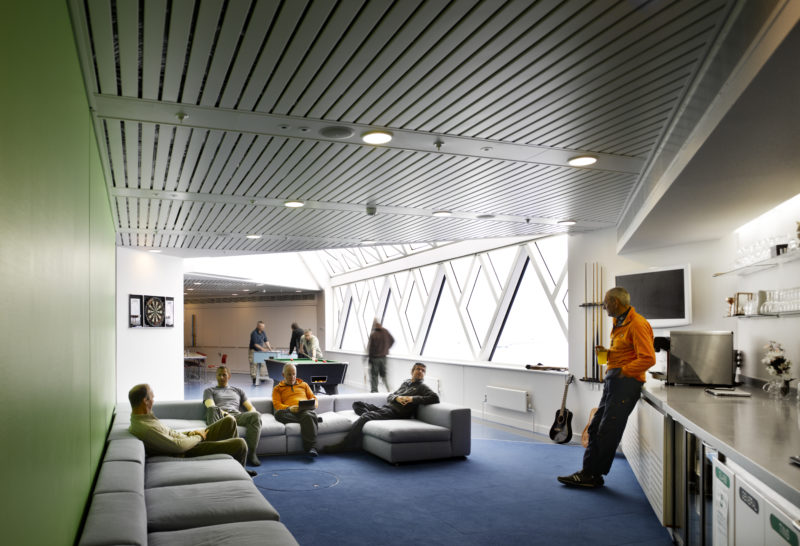
“When we arrived it was overcast and so cold and I could hardly imagine spending more than a few hours there let alone a few weeks. But its amazing how it grabs you. The cold is also incredibly enlivening as is the sense of isolation, which is quickly countered by the support offered by a small and very tightly knit community all working with a single purpose.”
Hugh Broughton is an award-winning British architect whose recent project, the conservation of The Painted Hall in Greenwich, has already won a 2020 Civic Trust Award, AABC Conservation Award and Selwyn Goldsmith Award. It is the first time in the history of the British Civic Trust Awards program that one project has received these three awards. But Broughton and his colleagues are famous for another, perhaps more weird, expertise: designing and building award-winning Antarctic bases.
The Antarctic has always been the most innovative continent when it comes to human design—from the earliest days of exploration it was a place where in order to survive, teams of humans had to observe and improvise and make near-hourly design decisions. I caught up with Hugh in his London office by teleconference. He had recently returned from New Zealand where he is designing a new version of that country’s historic Scott Base on Ross Island, Ross Sea, Antarctica. We talked about the challenges of creating human work and living spaces—it’s the coldest, driest, windiest continent. Half the year, the sun never rises and humans and non-humans alike live in utter darkness.
Broughton explained how, in addition to the vast technical challenges of the actual design, he focuses very intently on the experience of living there. How does one design towards the view—Antarctica for all its menace is stunningly gorgeous. Broughton also talked about representing New Zealand’s bi-cultural identity, through privileging the design sensibilities of the indigenous Maori people. The Maori have renowned craft practices, across carving and flax weaving among others, which often feature the organic forms of the curvilinear clouds ubiquitous to New Zealand. (The Maori name for New Zealand is Aotearoa, Land of the Long White Cloud.) He envisions Antarctic bases as a shared home, one that reflects the cultural identities of the home nation, while also supporting community and strong mental health in this notoriously difficult environment.
I asked Broughton if he had been one of those English lads longing to trace the journeys of his famed countrymen: Robert Falcon Scott and Vivian Fuchs, for example. He laughed, “No, actually not at all!” He explained how their first foray into Antarctic design came after their small, west London firm beat out much larger, global firms, to design Halley VI for the British Antarctic Survey. This came as a delightful surprise to the group and as they say, now there’s no looking back. The Halley VI design captivated and electrified designers and architects globally: the base was designed to move, or walk, in order to stay ahead of shifting ice. (The ice is on the move, and over time overtakes and inundates bases if not constantly removed.) Broughton has traveled to Antarctica on several occasions for site visits and noted, “Once you actually see Antarctica, it forever shifts and shapes your ideas of the terms ‘environment’ and ‘ecology.’”
—Leslie Carol Roberts
THE BELIEVER: Your work in Antarctica started when your firm won a competition to redesign Halley VI station and the ideas really blew everyone away.
HUGH BROUGHTON: The design was a response to the special environment at Halley. The base is located on a freezing, flat, floating ice shelf which can fracture off as giant icebergs. The snow level continually rises by about 4 feet per annum and never melts. Winter lows reach -57 degrees centigrade and in summer the temperature never rises above freezing. The base needed to be mobile and to climb out of the rising snow levels. That’s why we opted for a modular solution. The aerodynamic modules are linked together in a line perpendicular to the prevailing wind so that the windward side remains icy allowing vehicles to . They are elevated on hydraulic legs which can climb above the snow and supported ion giant skis. When it is necessary to relocate the base, the modules can be disconnected one from another and skied to a new safer location. This first happened in 2016.
BLVR: Can you talk more about how the structures move? Specifically in response to the always-moving ice on which they exist.
HB: That solution was very specific to the circumstances at Halley where the ice shelf is so dynamic so the base needed to be relocatable. It’s one of only two stations in Antarctica built on a floating ice shelf—the other is the German station at Neumayer built on the Filchner Ice Shelf—but that is a much more stable situation. I doubt many others will ever be built to require this mobility unless it forms a part of the construction strategy i.e., build it somewhere else and ski it into position. The idea of using hydraulics to elevate buildings above rising snow levels is one that will be adopted more widely though I am sure. It is already used at the French-Italian base—Concordia—and at Neumayer, whilst the US base at South Pole also uses a lifting system, based on screw jacks.
BLVR: Antarctica drives global weather; how do the reports of increased rates of ice melt from 1979—2017 affect your thinking on the design of Scott Base, your current project?
HB: We are already seeing the sea ice melting and breaking out in front of Scott Base more regularly. It used to occur every few years but it has happened in both the last two years. If the sea ice does melt more frequently the natural conclusion might be that the sea levels will rise however scientists have told us that they will in fact drop in this part of Antarctica even though they may rise elsewhere. The melting of the sea ice has significant impact on routes away from the base which become limited for scientists. Tsunami is a risk and for this reason we have designed the base above the likely Tsunami line. We are also very conscious of rising temperatures and the risk that the base may experience rainfall in the next fifty years. For this reason the building shell will be designed to be waterproof as well as wind proof and ice proof.

BLVR: I am curious to hear your experience of the continent as an ecology—and what you found and find most surprising about the experience of Antarctica. It’s hard to describe to those who have not lived there what that ecosystem feels like.
HB: I remember when I first visited Halley. On the surface it’s a very bleak spot—a white, freezing desert without apparent geographical features. When we arrived it was overcast and so cold and I could hardly imagine spending more than a few hours there let alone a few weeks. But its amazing how it grabs you. Quickly the patterns that the wind makes on the ice and the different cloud formations become the peaks and valleys of a more temperate environment. The cold is also incredibly enlivening as is the sense of isolation, which is quickly countered by the support offered by a small and very tightly knit community all working with a single purpose. Subsequent visits have revealed other marvels of this extraordinary place—wildlife, remarkable topography and history—especially around Scott Base. I never tire of visiting and each time I do I am consumed by excitement when I first step foot on the ice—it’s the very elemental nature of the continent which I think brings everything into a very sharp focus.
BLVR: There is a weird sci-fi, Star Wars vibe to the design—were you thinking in that way when you came up with what would make for great polar design?
HB: I remember presenting the design to the crew at Halley V. I explained all the performance aspects of the design and how they had been derived in response to the environment and then one of them asked “So what was the real inspiration?” I responded with more information on the climate and the wind and asked again—”No, come on, there must have been some sci-fi influence?”
So I came clean—not a day passed by when I didn’t have a book about the Thunderbirds (created by Gerry Anderson) by my desk. Many of the ideas also stemmed from a close observation of Star Wars movies—the big window in the main module is a homage to the final scene in The Empire Strikes Back and the whole base loosely references the All-Terrain Walkers in action on the ice planet Hoth. A sci-fi aesthetic was never a design driver but it was certainly a little bit of fun which we had on the way. In all seriousness however the futuristic nature of these buildings is a little inevitable. They are generally elevated above the ground to reduce snow drift, aerodynamic to reduce wind drag, with smaller dark windows to reduce heat loss and glare so instantly resonate with the idea of a space station no matter how respectful they are of the environment… or maybe because of it.
What goes around comes around, however. It was really exciting when James Cameron’s team contacted us to ask for information about Halley to inform their designs for a series of remote laboratories in the movie Avatar. More recently we were also thrilled that Halley appeared in the movie Where’d you go Bernadette? starring Cate Blanchett as an architect who travels to Antarctica to design a research station. The sketches she produces are based on my original sketches for Halley and the completed station appears in the credits. It’s nice to see reality influencing fiction just as it’s fun to use fiction when designing for reality.

BLVR: Your design also points towards ideas of base as “home”—when I was in the Antarctic, I visited thirty-two bases and it was always fascinating how these really bland containers were decorated to try and get that vibe—posters, photos, stuffed animals. Humans like to set up camp beyond just structure. Particularly in extreme locations.
HB: Yes, creating a “home away from home” has always been an important aspect of our work in Antarctica. At Halley we did this by imagining the day of a variety of different users of the base from the moment they woke up to the moment they went to bed. We thought about the feel of the floor as they swung themselves out of bed. We considered the lighting in the bedrooms and circulation spaces and the color scheme to help them overcome the winter blues. We worked with a color psychologist on this aspect and also developed a special alarm clock to wake people with a false dawn in the darkness of winter. Wherever possible we also gave thought to sensory deprivation. The stair which leads to the upper level of the social module is lined with Lebanese Cedar veneer because it gives off a pleasant smell of trees in place where there are no plants. What we didn’t do was fill the base with pictures of Britain—most people who work in Antarctica do so because they love the place and they don’t need lots of pictures of the English countryside to get in the way of that relationship.
In our work on Scott Base we are taking the interior design to a new and exciting level. The design has a strong sense of welcome. Significant thought is going into ways in which the design can reflect New Zealand’s cultural and natural landscape, capturing the essence of what it means to be a New Zealander, by conveying Māori values and reflecting New Zealand’s history of involvement in Antarctica. Central to Māori values is a sense of shared responsibility for the mauri, or life force of the environment, and for the health and well-being of all people who depend upon it for their survival and this connectivity will be a key feature of the interior design. For example windows are carefully placed to make the most of natural light and reinforce connections with the Antarctic landscape. The layout has also been developed to include lots of places for people to stop and chat as they walk from one place to another, fostering collaboration and well-being.
BLVR: Many Americans have grown up with few thoughts on Antarctica—until recent talk about ice melt. However in the UK, you are steeped in these histories because of the “Heroic Age” of exploration and the race to the South Pole in the early 20th century. Let’s play the game we Antarcticans all love: who is your favorite explorer and why?
HB: I have been lucky to visit the huts of Scott, Shackleton, and Hillary on my visits to Scott Base and so I am going to answer this question from a purely architectural perspective. The Scott Hut next to McMurdo was cold and forbidding—so cold in fact that they only used it as a store and continued to live on the RRS Discovery, moored out in McMurdo Sound, during Scott’s first expedition to Antarctica. Shackleton’s hut is far more welcoming with sheepskin rugs, views out and a strong sense of community but it still feels very isolated with the potential for all the heat from the fires to rise into the roof void leaving the floor area quite cold. Hillary’s hut of 1957 is altogether different—a massive step change. It was designed by Frank Ponder of the Ministry of Public Works and was a tour de force. It was prefabricated, well insulated and beautifully decorated inside. New Zealanders understand how to live in extreme and remote places and this is so evident in this hut. It’s been beautifully restored by the New Zealand Antarctic Heritage Trust and lots of the ideas inside will definitely find their way into the new Scott Base. So—from a purely architectural perspective—I am going to go for Sir Edmund Hillary—although I think there are plenty of other reasons why he is also considered one of the greatest explorers of all time.
BLVR: Mine is Frank Worsley for mind-blowing navigational skills in those redesigned life boats—but I do have a soft spot for Edmund Hillary riding on a tractor to the South Pole from the Ross Sea. It’s fascinating how Antarctica seems to be a perfect lab for innovation.
HB: I have recently enjoyed reading Michael Palin’s biography of HMS Erebus—the ship that was fatefully lost in the North West Passage in the latter part of the 19th century. Before that it was captained by James Clark Ross who explored Antarctica and reached the Ross Ice Shelf in the 1840s. He gave his name to the eponymous island and his first mate gave his name to McMurdo Sound whilst they named the Royal Society Range after their funders and Mount Erebus and Mount Terror after the two ships in which they were sailing. It’s amazing to think of these crews exploring Antarctica with really basic clothing, away from home for three to four years and using the stars and the sun for navigation. Maybe in years to come we will see the first people to reach Mars and beyond in the same light—real pioneers to inspire future generations and demonstrate humankind’s incredible desire for research to the benefit of the entire race.

BLVR: And then you rather quickly became the go-to firm for other national science expeditions in the Antarctic? How have you adapted from experience some of your original ideas?
HB: Inevitably there are lessons learned—good and bad—which we bring from one project to the next. You need to be careful, however. This is not a cookie cutter process. Each site has its own challenges—Halley had to deal with the specific requirements of a dynamic ice shelf location, the Spanish base Juan Carlos 1 is only occupied in the summer and has no prevailing wind direction (it blows hard from everywhere!) whilst Scott Base is being built on rock amongst existing structures and with existing science installations, a coast and the main route from McMurdo to the airfields to contend with. The sustainability goals between the bases are however common as is the requirement to minimize effort to maintain and operate the bases. I find the different cultural emphasizes especially interesting. In many ways the bases are like embassies on the ice and need to capture the essence of the host nation and I have really enjoyed working out what that means and how it can be transferred into a design
BLVR: Do you think Antarctica is a “test kitchen” for how architecture can evolve under the pressures of climate change? How does your Antarctic work effect more conventional human design work around how we occupy ecologies, ecologies changing and facing “extreme” weather, like one does in Antarctica or other deserts?
HB: I think it definitely has that potential. The buildings all need to be very well insulated and air tight. They need to minimize their environmental footprint through reduced to zero use of fossil fuels and also reduce their water usage—something which is particularly relevant to dry places all around the globe. They need to be designed in harmony with their environment, responding to strong winds, cold temperatures and snow drift. Internally they need to support the well-being of people living in isolation for long periods—encouraging collaboration but also giving space for people to be alone or in small groups. All of these features are relevant to more temperate environments. These bases are infra-structure free self-supporting facilities. With increasing pressure on natural resources and an ever more unpredictable climate the solutions which have been developed for buildings in Antarctica can have increasing relevance for buildings elsewhere in the world. Hopefully!




